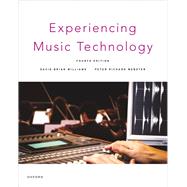Experiencing Music Technology is a comprehensive introduction to the broad topic of music technology as it exists in contemporary practice across music making, music production, and music teaching and learning. Unlike other music technology books, EMT is designed not only as a major text for a course of study but also as a resource and reference guide for a wide audience of amateur, student, or professional musicians both inside and outside the academic setting. Although it is introductory in scope, it provides considerable depth of coverage anchored around a thread of ten core music technology competences integrated throughout the book.
The newest edition of EMT enters the world at a time of real change in education that favors independent and creative thinking by learners. Our fervent hope is that the book meets the need of newer trends in music curriculum design to integrate technology understanding into specific courses within the discipline and to serve the needs of more modular course design in creative ways. The exciting development of the e-Book edition with its many links to internal and external resources helps to support multiple courses, curricula, and interdisciplinary connections.








